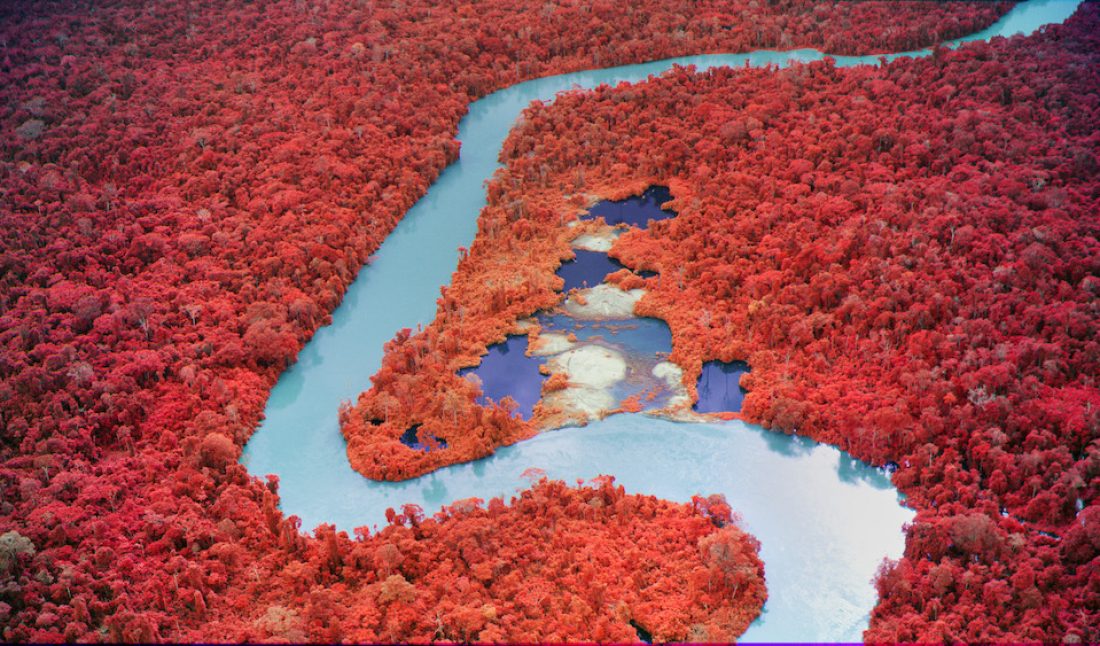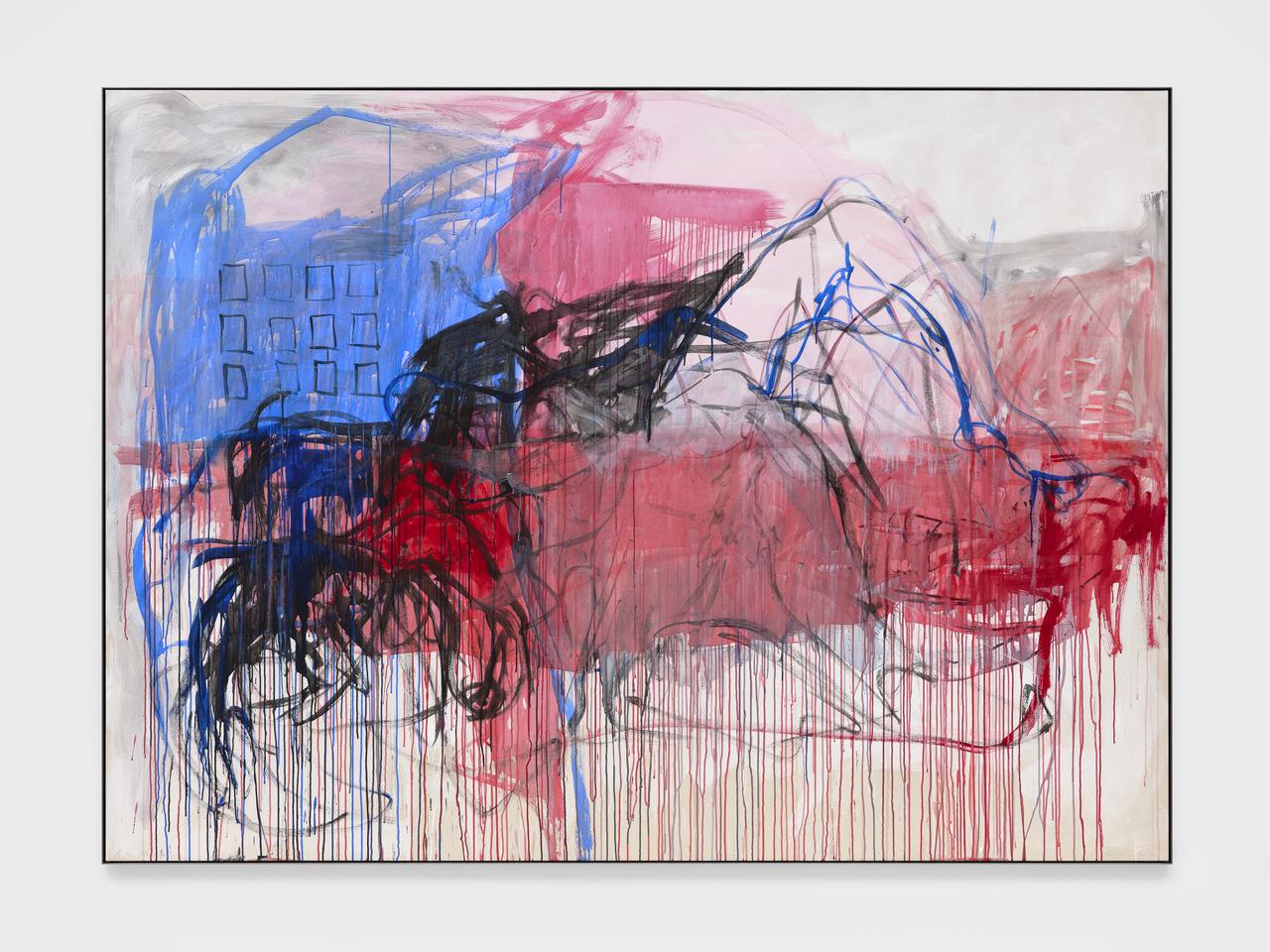Visually arresting in its aerochrome strangeness and temporal ambiguity, Richard Mosse’s latest exhibition “Broken Spectre” at 180 The Strand in London overwhelms with sublimity and horror, deploying vibrant hues of alizarin crimson, amaranth, scarlet, vermillion, madder, and lac in a contemporary depiction of environmental devastation in the Brazilian Amazon.
On view now through April 9, the images are a result of Mosse’s custom-made camera, employing infra-red film and military-grade technology to artfully capture the scar tissue of the Amazon. Featuring large-scale topographic maps of devastated landscapes and nocturnal photographs of rich rainforest biome, the images—a culmination of three years of careful and painstaking documentation across remote parts of the Brazilian Amazon – show the deceptive otherworldly beauty prevalent in the different fronts of the ecological warzone.
An Irish conceptual documentary photographer, Mosse is well-known for his powerful large-scale contemporary depictions of war-torn villages, uprooted villagers, temporary conquerors, and the deceptively luxuriant landscapes that emerge from the aftermath of war and conflict.
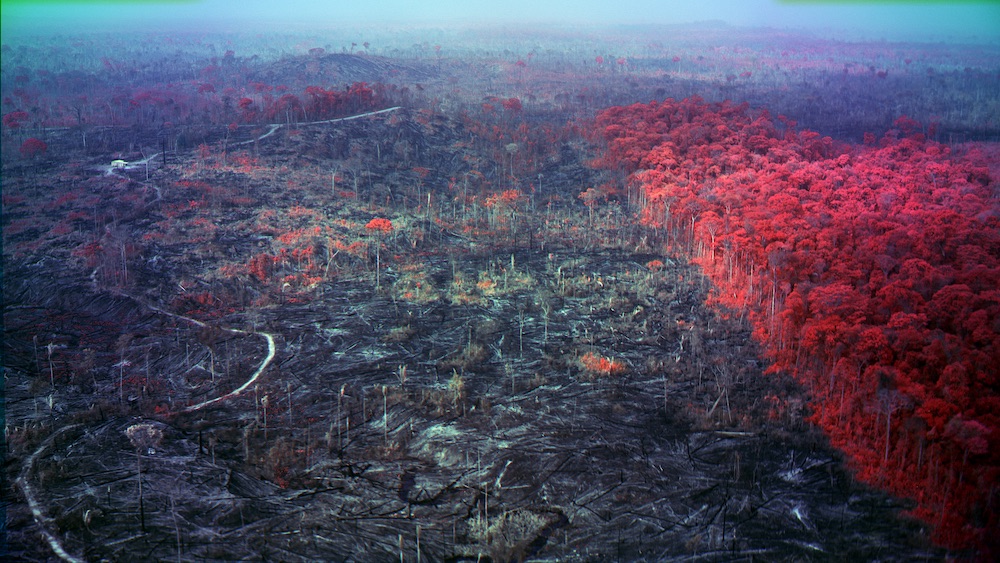 Still from Richard Mosse’s “Broken Spectre,” 2022, five channel 4K video with 20.4 surround sound, courtesy of the artist, Jack Shainman Gallery, New York and carlier | gebauer, Berlin/Madrid, © Richard Mosse, co-commissioned by the National Gallery of Victoria, VIA Art Fund, the Westridge Foundation and Serpentine Galleries.
Still from Richard Mosse’s “Broken Spectre,” 2022, five channel 4K video with 20.4 surround sound, courtesy of the artist, Jack Shainman Gallery, New York and carlier | gebauer, Berlin/Madrid, © Richard Mosse, co-commissioned by the National Gallery of Victoria, VIA Art Fund, the Westridge Foundation and Serpentine Galleries.
Documenting some of the most significant humanitarian crises of our time, his photographs exist at the intersection of contemporary art and photography reportage, capturing the disquieting journeys of refugees across Europe and rendering the landscapes of war in the Democratic Republic of Congo as he used chromatic dislocations to create new perspectives on conflict, lining the walls of the 2013 Biennale and landing him the Prix Pictet of 2017.
Registering a spectrum of infrared light undetectable to the human eye, he would limn green landscapes and soldiers’ uniforms in vivid hues of hot pink and crimson, torquing scenes of intrinsic humanitarian tragedy with a distinct coloration that makes them all the starker by their peculiar color. Mordant and macabre, while illogically and irrevocably sublime, the surreal and evocative images conjure lines from a second world war poem, Violets from Oversea (1915), by the British soldier Roland Leighton who, on duty far from home, wrote to his faraway sweetheart, relating the odd beauty of violets as they grew from a soldier’s mangled head:
“Violets from Plug Street Wood,
Sweet, I send you oversea.
(It is strange they should be blue,
Blue, when his soaked blood was red,
For they grew around his head:
…
(And you did not see them grow
Where his mangled body lay
Hiding horror from the day;
Sweetest it was better so.)”
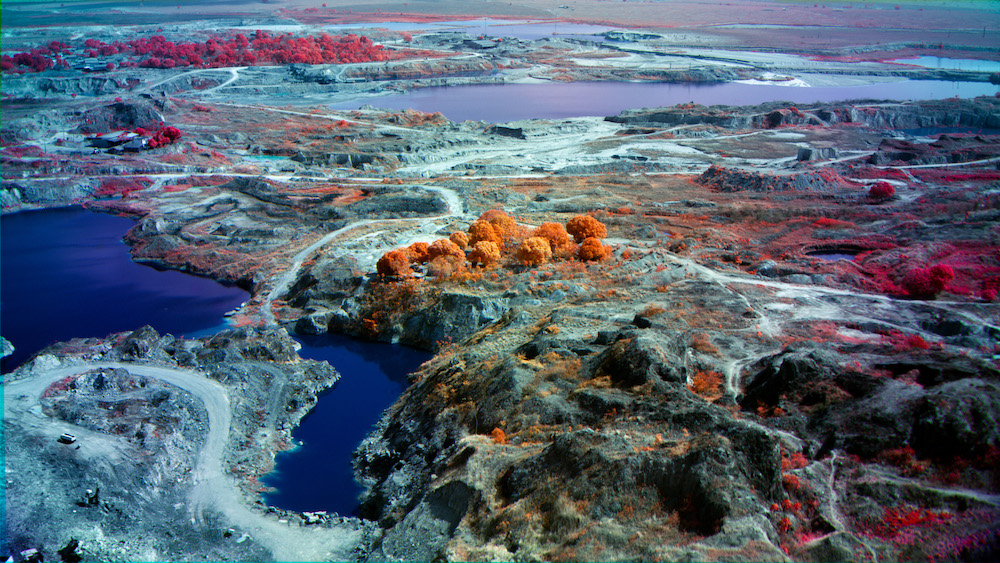 Still from Richard Mosse’s “Broken Spectre,” 2022, five channel 4K video with 20.4 surround sound, courtesy of the artist, Jack Shainman Gallery, New York and carlier | gebauer, Berlin/Madrid, © Richard Mosse, co-commissioned by the National Gallery of Victoria, VIA Art Fund, the Westridge Foundation and Serpentine Galleries.
Still from Richard Mosse’s “Broken Spectre,” 2022, five channel 4K video with 20.4 surround sound, courtesy of the artist, Jack Shainman Gallery, New York and carlier | gebauer, Berlin/Madrid, © Richard Mosse, co-commissioned by the National Gallery of Victoria, VIA Art Fund, the Westridge Foundation and Serpentine Galleries.
With “Broken Spectre” Mosse takes viewers deep into the heart of the Brazilian Amazon, using a range of mediums and scientific imaging technologies in a contemporary rendition of the world’s most crucial ecological warzone.
Mosse chose to focus his lens on the deforestation of the Brazilian Amazon because, as a vast intergeneration problem, the crisis only goes back a few decades (to the 1970s), unaccounted for by ancestral acting, and is wilfully being carried out in the present moment. In just a few years, the lack of regression would cause irreversible damage from which we could no longer come back. Inspired by the French anthropologist Claude Levi-Strauss’s 1955 memoir Tristes Tropiques, whose name befell Mosse’s previous exhibition that included many of these works, the routes the artist would take on his journey were mapped out, going from Cuiaba to the route of General Rondon’s telegraph line.
However, depicting the issue aesthetically came with more trying dilemmas. The environmental devastation of the Amazon being such a hideously complex issue, it involves multiple processes almost impossible to capture in space and time, the scale of which is almost too vast to comprehend, too minute to perceive, and too normalized to see.
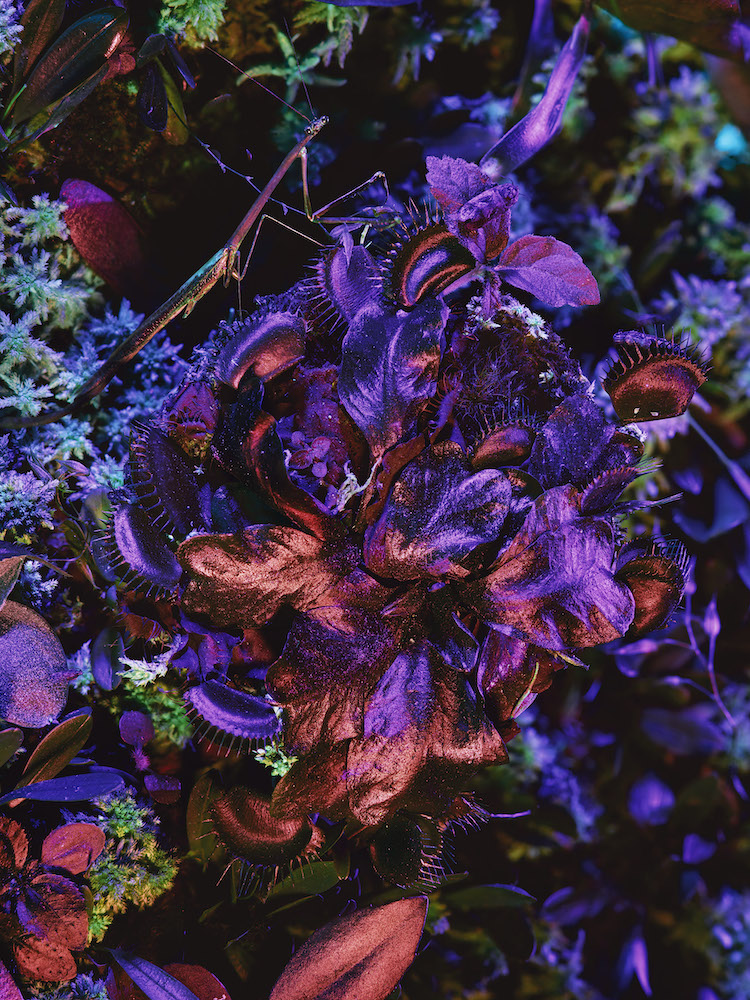 Still from Richard Mosse’s “Broken Spectre,” 2022, five channel 4K video with 20.4 surround sound, courtesy of the artist, Jack Shainman Gallery, New York and carlier | gebauer, Berlin/Madrid, © Richard Mosse, co-commissioned by the National Gallery of Victoria, VIA Art Fund, the Westridge Foundation and Serpentine Galleries.
Still from Richard Mosse’s “Broken Spectre,” 2022, five channel 4K video with 20.4 surround sound, courtesy of the artist, Jack Shainman Gallery, New York and carlier | gebauer, Berlin/Madrid, © Richard Mosse, co-commissioned by the National Gallery of Victoria, VIA Art Fund, the Westridge Foundation and Serpentine Galleries.
Artfully rendering its subjects and ravaged landscapes, Mosse hence sought to address the challenge by breaking it down in scale, unveiling the different fronts of the ecocide from macro to micro, human to animal, and fauna to flora.
The show starts with wide-scale images of multi-spectral footage taking precedence throughout the space, revealing psychedelic aerial images of charred and barren landscapes, and flashy chromatic dislocations exposing otherwise invisible traces of environmental damage. Intensive Cattle Feedlot shows a fuchsia tree line snaked around a labyrinthine feedlot; Subterranean Fire (2020) reveals buried traces of fire advancing along desiccated underground roots in the Pantanal ecosystem; and the diptych Juvencio’s Mine (2020) reveals the devastation of illegal gold mining practices, coalescing fiery oranges, hot pinks, and acid greens, to spill an aesthetically pleasing story of destruction that unveils the deceptively sublime beauty that lies in environmental devastation. From afar, the widescale photographs resemble color fields of abstract paintings upon which a closing in divulges minute photographic details of lush foliage, winding rivers, and cultivated valleys imbued with chromatic dislocations of alizarin crimson, lac, fuchsia, turquoise, electric, and pastel green and murky blue.
Black-and-white stills and photographs document forests burning, swathes of smoke, wildlife under pressure, and Indigenous activists. On the right-hand side, a room draped with walls pitch black assimilates the very foreground of the displayed nocturnal photographs as it creates a stark contrast with the exotic fluorescent flowers, insects, and biodome that houses its subject in bioluminescent detail. Eccentric and serene, the images, made using ultraviolet light, exoticize subjects of the rainforest biome with translucent and psychedelic hues that reveal a galaxy of exuberant life.
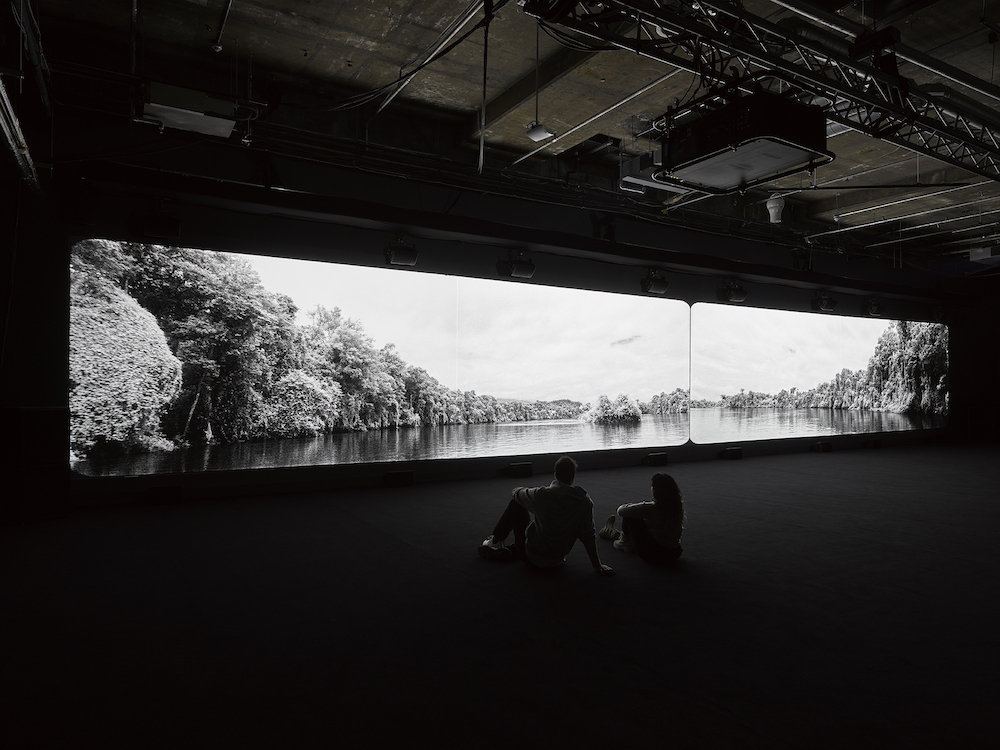 Installation view of Richard Mosse’s “Broken Spectre” at 180 The Strand in London, photo by Jack Hems.
Installation view of Richard Mosse’s “Broken Spectre” at 180 The Strand in London, photo by Jack Hems.
The exhibition space of 180 The Strand parallels the works themselves with its vast range of room shapes and sizes, juxtaposing the images of environmental crimes and damage with that of a rainforest floor teeming with species, moving between different temporalities. One, from the piercing vision of a satellite camera, another, from that of a micro-organism at the microscopic level. Displaying the different fronts of environmental damage, and the species we stand to lose, Mosse overwhelms the viewer with a sheer abundance of beauty, subject, and color in a phasing of ecological narratives that shifts across environmental and anthropocentric wavelengths.
After an extensive first-floor perusal, a stairway culminates the visitor’s experience with a brutal video installation of sensory overload. 74 minutes of stomach-churning images showing rivers being pumped of filth, machinery churning along forests paths, shots of gold miners, illegal loggers, cattle ranchers, and wildfires over a 20-meter-wide screen matched by an original soundscape by Ben Frost that pounds relentlessly with a deep chest-rattling bass. Flicking between monochrome and vivid, hallucinatory color, the effect is dizzying and abating, amplified by Frost’s cacophony of buzzing insects and electric whirring, that ramps up to a final eerie high-pitched din, paralyzing our senses as we witness the horror of the Amazon being brutally singed and devastated. Hypnotic, mesmerizing, and deeply disturbing, the film’s irregularly interspersed scenes of action and stillness, taken from close-up and then distant, below and then from above, in black and white and then in electric color, consummates the viewer’s experience with a striking commotion of beauty and devastation that—while perfectly matched to the artist’s unique style of expression—hits a nerve that activates one with an adamant desire for action.
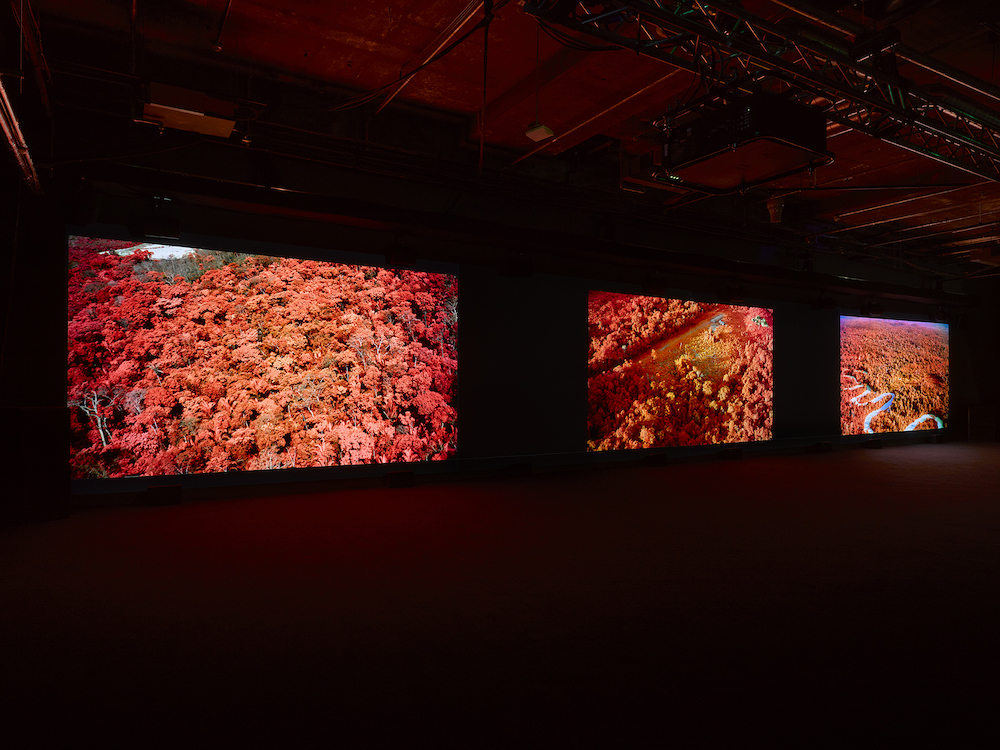 Installation view of Richard Mosse’s “Broken Spectre” at 180 The Strand in London, photo by Jack Hems.
Installation view of Richard Mosse’s “Broken Spectre” at 180 The Strand in London, photo by Jack Hems.






